
Multi-day hands on lesson to teach strategies for comparing sets: matching, counting, equal shares
- Subject:
- Mathematics
- Material Type:
- Lesson Plan
- Author:
- HEATHER LANDRETH
- Date Added:
- 07/30/2019

Multi-day hands on lesson to teach strategies for comparing sets: matching, counting, equal shares
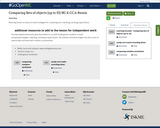
Multi-day hands on lesson to teach strategies for comparing sets: matching, counting, equal shares
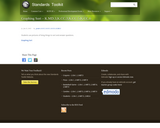
In this assessment task students will cut and classify pictures. They will be asked to explain how the pictures are sorted, count the number in each group, identify the group that is greater and write the correct number from 1-20. Assessment sheets and a rubric are provided.
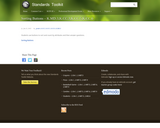
In this assessment task students are asked to sort buttons by the number of holes. They will label how they sorted the groups and then draw a circle around the group with the largest number of buttons. An assessment sheet and rubric are provided.
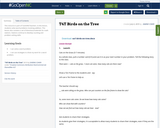
This resource is part of Tools4NCTeachers.
In this lesson, students solve word problems involving addition. This lesson also contains a set of directions/materials for math stations. Stations continue to develop counting and problem solving skills.
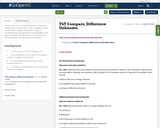
This resource is part of Tools4NCTeachers.
In this lesson, students solve a word problem using a strategy of choice and share the strategy to develop the concept of representing and solving problems involving addition and subtraction within 20. This lesson format may be used with any problem type appropriate for the grade.
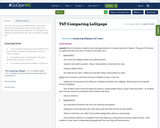
This resource is part of Tools4NCTeachers.
This lesson focuses on comparing sets and numerals using terms greater than, less than, and equal to. The main goal is for students to generate their own sets to compare to a given set.
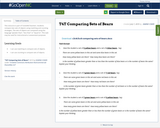
This resource is part of Tools4NCTeachers.
Students compare two sets of objects using matching and counting strategies. The sets of objects are compared using the language "greater than", "less than" or "equal to".
This task may be used for instructional or assessment purposes.
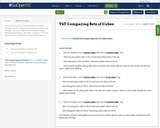
This resource is part of Tools4NCTeachers.
Students compare two sets of objects using matching and counting strategies. The sets of objects are compared using the language "greater than", "less than" or "equal to".
This task may be used for instructional or assessment purposes.
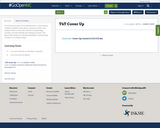
This resource is part of Tools4NCTeachers.
In this activity, students are given clues about a mystery number card. Students listen to the clues, find the corresponding quantity, and then identify the matching numeral. The goal of this activity is to develop flexibility in representing numbers in a variety of ways.
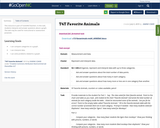
This resource is part of Tools4NCTeachers.
In this task, students interpret and answer questions about a graph. The task may be used for instructional or assessment purposes.

This resource is part of Tools4NCTeachers.
In this task, students interpret and answer questions about data collected on a chart. The task may be used for instructional or assessment purposes.
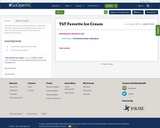
This resource is part of Tools4NCTeachers.
In this task, students interpret answer questions about data on a chart. The task may be used for instructional or assessment purposes.
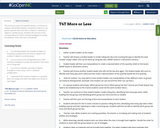
This resource is part of Tools4NCTeachers.
In this lesson, students will identify whether a quantity of objects in one group is greater than, less than or equal to a quantity of objects in another group. Students will use one-to-one correspondence (or other counting strategies) to answer the question: How many are in one group?
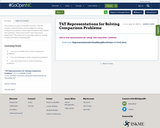
This resource is part of Tools4NCTeachers.
This file contains representations and strategies for solving comparison problems. These representations help answer the questions, "How many more?" and "How many fewer/less?" This resource is especially useful for making comparisons when analyzing data.
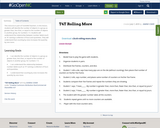
This resource is part of Tools4NCTeachers.
In this lesson, students will identify the number of objects in a group as greater than, less than, or equal to the number of objects in another group, for numbers 1-5. Students will understand the relationship between number labels (such as "4" naming a collection of four) and quantities. They will understand that counting by ones increases the quantity by one more.
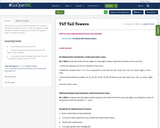
This resource is part of Tools4NCTeachers.
In this lesson, students use number cards to create the highest two-digit numbers possible to develop the concept of using place value to compare numbers.
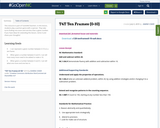
This resource is part of Tools4NCTeachers.
In this lesson, students play a partner game with a spinner. They take turns finding one more and one less than a given number.
If you have ideas for extending this lesson, remix it and share your thoughts!
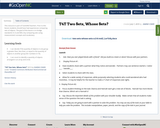
This resource is part of Tools4NCTeachers.
Prior to this lesson students should have had experiences comparing sets of objects.
The goal of this lesson is to bridge standards CC.6 and MD.2 by comparing sets using measurement concepts and vocabulary.

This resource is from Tools4NCTeachers. In this lesson, partners use both centimeters and inches to measure objects to develop their understanding of the relationship between the length of a unit and the resulting measurement. With teacher guidance, they will solidify their understanding that the objects themselves do not change when measured using different units. Students should have had multiple experiences measuring using standard units before attempting this lesson.